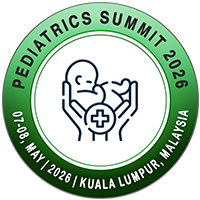
Kuldeep Dhariwal
NMC Specialty Hospital, UAEPresentation Title:
Rare case of cerebral venous thrombosis associated with heterozygous factor V Leiden mutation
Abstract
Introduction: Cerebral venous sinus thrombosis (CVST) is a rare but serious condition in which blood clots obstruct the dural venous sinuses, the vessels that drain blood from the brain. This obstruction can lead to decreased cerebrospinal fluid and elevated intracranial pressure. As a result, cerebral hemorrhage and venous infarction can occur, both causes significant brain damage. The development of venous clots can be attributed to stasis, hypercoagulability, and endothelial damage. Risk factors include infections, trauma, prothrombic disorder, recent intracranial surgery. CVST incidence rates reaching up to 7 cases per million among children. Factor V Leiden mutation, activated protein C resistance is the most common inherited risk factors to develop venous thrombosis in infant and children.
Case report: 2.5-year-old male child admitted with complaints of multiple episodes of vomiting, drowsy, reduced interaction with parents. Clinical examination showed reduced movement of the right lower limb. Right lower limb appeared hypotonic and flaccid. CSF examinations showed turbid fluid, Wbc -1490 cells/microliter 85% neutrophil, 10% lymphocyte. CSF culture – no growth. Encephalitis screen - negative MRI (BRAIN) showed Non enhancing T2 FLAIR hyperintense and T1 hypointense region involving the left thalamus and basal ganglia and internal capsule mildly compressing 3rd ventricle with asymmetric dilatation of left lateral ventricle and midline shift to right compressing the body of right lateral ventricle. Hemorrhagic changes in the affected left deep grey matter nuclei, suggestive of acute necrotizing encephalitis or deep cerebral vein thrombosis. Real time PCR revealed heterozygous mutation of factor V leiden.
Diagnosis: Cerebral venous thrombosis associated with heterozygous factor V leiden mutation.
Treatment: Low molecular weight heparin, oral anticoagulants.
Conclusion: Factor V mutation is a common inherited risk factor for venous thrombosis in children. Due to the rapid and fatal consequences of this cerebrovascular event, prompt response with an antithrombotic must be administered to prevent any further complications. Further studies are essential to determine the most appropriate lifelong anticoagulation, its posology and duration in the pediatric population.
Biography
Kuldeep Dhariwal is a Consultant Paediatrician in NMC Specialty hospital, Dubai. He obtained his MD(paediatrics) degree from University Of Rajasthan , Jaipur, India in 2005. He has more than 20 years’ experience in paediatrics and paediatric subspecialty field. He has major interest in rare genetic diseases, neurology and intensive care cases. He presented many pediatric topics as a speaker in various national and international conferences. Six article published in prestigious Pubmed indexed international journals.

